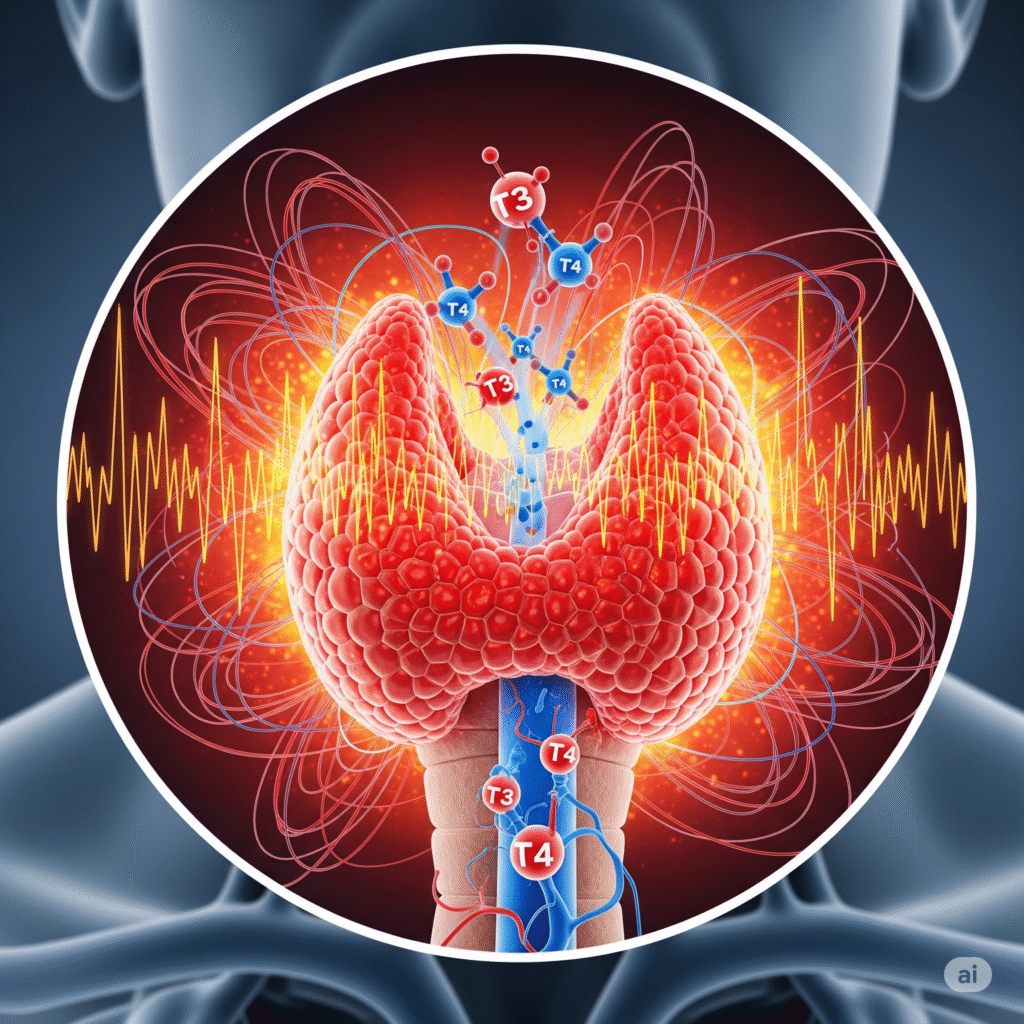Thyrotoxicosis
Introduction
Thyrotoxicosis is a clinical condition due to excessive levels of thyroid hormones (T3 and T4) in the bloodstream regardless of the source. It leads to a hypermatabolic state that affects many organs and systems in the body. It is often used interconnected with hyperthyroidism, but they are not at all similar – all hyperthyroidism causes thyrotoxicosis, but not all thyrotoxicosis is caused by hyperthyroidism.
Major Features:
- Increase in metabolic rate
- Heat intolerance
- Common Symtoms Weight Loss, Despite Normal or Incresed Epitide
- Fatigue Irritability
- Lid retraction & Lidleg

Types of Thyrotoxicosis
Grabes Disease
The thyroid gland itself makes too much hormone, usually due to the disease of graves, toxic nodules or goh.
Toxic Multinodular Goiter
The additional TSH is manufactured by the pituitary gland (eg TSH-recluded tumor), which oversutes the thyroid.
Thyroiditis related thyrotoxicosis
The inflammation thyroid gland leaked collects hormones in the blood (eg, subcutaneous, silent, or in postpartum thyroiditis).
Toxic Adenoma
It happens when a person takes a mistake or deliberate thyroid hormone medicine.
Causes Thyrotoxicosis :
- Autoimmune antibodies reduce thyroid hormone production
- Many nodules produce more thyroid hormones independently
- Single thyroid nodule secret uncontrolled thyroid hormone
- Thyroid medicine overdose increases hormone levels
- Pituitary tumors have increased TSH and hormones
- Viral inflammation release thyroid hormone stored
- Hormone leakage from painless inflammatory gland
- Thyroid inflammation increases hormone levels after delivery
- High iodine triggers additional hormone production
- Ovarian tumor active thyroid hormone selects ectopically
- Cancer cells produce thyroid hormones elsewhere
- Radiation damages thyroid, temporarily releases hormones stored
Clinical features of Thyrotoxicosis:
Lose weight
Despite eating well, the body burns energy rapidly, which reduces weight.
Coordination
Increased thyroid hormones increase heart rate, causing noticeable and rapid heartbeat.
Heat intolerance
The body is easily overheated due to an increase in metabolism and excessive hormone levels.
Nervousness and anxiety
Additional hormones eliminate the nervous system, causing restlessness and emotional instability.
Tremors
The fine shocks of the hands are caused by the overstimulation of the muscles by thyroid hormones.
Symptoms associated with Thyrotoxicosis
- Rapid or fast heartbeat often feels in the chest
- Excessive sweating in normal or cold temperature
- Hot or mild season feeling hot and uncomfortable
- Uneasy feelings of restlessness, irritability, and anxiety
- Fine shocks or shocks in hands or fingers
- Constant fatigue and weakness despite adequate sleep
- Frequent or loose bowel movements due to rapid metabolism
- Unintentional weight loss despite increased or normal appetite
Ayurvedic Treatment
In Ayurvedic Science, Hyperthyroidism is related to agni dusti (digestive fire) or alteration in metabolism. The agni is called as Jatharagni in the Gastrointestinal tract, at tissue level is called as Dhatvagni, and the agni present in the five elements of the body is called Bhutagni. Together, they convert food into energy and tissue nourishment.
Role of Doshas in Digestion
- Pachaka Pitta – helps digest food.
- Samana Vata – supports digestion and works closely with Pachaka Pitta, like air supporting fire.
- Kledaka Kapha – moistens food and protects the stomach.
Different doshic corelations with Hyperthyroidism:
Udana Vata:
Udana Vata is located in the chest and throat, near the thyroid gland. The dysfunction in the fuction of udana vata can lead to same symptoms of thyroid gland dysfunction. When Udana Vata gets disturbed, it affects the digestive fire and overall metabolism.
Samanavrita Udana :
The aggravated Samana Vata blocks Udana Vata.
- This increases the digestive fire, destroys protective Kapha, and creates excess heat in the body.
- Udana Vata then reacts strongly, stimulating the thyroid gland to produce too many hormones.
- The result is an overactive metabolism– like what happens in hyperthyroidism.
Pittavrita Udana:
Sometimes, Pitta can block Udana Vata. This again leads to overexpression of Udana and overstimulation of the thyroid gland, causing excess thyroid hormones and disturbed metabolism.
In hyperthyroidism:
- Pitta increases, making metabolism fiery.
- Kapha decreases, so the natural cooling and balancing effect is lost.
- Vata and Pitta rise together, worsening the imbalance.
This trio leads to weight loss, heat, restlessness, and other hyperthyroid symptoms.
Teekshnagni and Bhasmaka Roga:
- Teekshnagni – digestive fire becomes too strong due to excess Pitta and Vata.
- Bhasmaka Roga – food burns instead of digesting, producing little nourishment. This causes weakness, tissue loss, and weight reduction, similar to what happens in hyperthyroidism.
Investigations in Thyrotoxicosis
- Levels of T3, T4 and TSH levels. In thyrotoxicosis, T3 and T4 are high, TSH is low in primary cases.
It helps to diagnose graves disease by detecting antibodies that stimulate thyroid.
Assesses how much iodine the thyroid absorbs. High uptake overproduction (eg, graves’ indicates, low uttake in thyroiditis.
The thyroid gland structure is used to detect nodules, goh, or inflammation.
Elevated ESR subcutaneous can suggest thyroiditis, especially if the thyroid is painful.
High levels suggest endogenous hormone release (thyroiditis); Low in so -called thyrotoxicosis.
It is used if the secondary thyrotoxicosis is suspected due to TSH-survived tumors.
